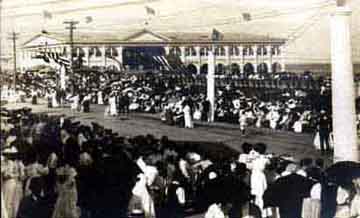|
(Return to PREVIOUS PAGE or ASBURY INDEX or MAIN PAGE) JAMES A. BRADLEY AND ASBURY PARK (continues) Bradley's generosity was immense in the donation of land for schools, churches, and many other worthy establishments. He sold lots cheaply and often advanced money to build. He developed and maintained the athletic grounds (behind the present-day Asbury Park High School) without deriving any remuneration from them. With his own money - $10,000 a year - he maintained the boardwalk (he put up a sign reminding people of this fact). He served as the first school teacher, postmaster, and newspaper editor. With characteristic resolve, he purchased the Educational Hall building from the Philadelphia Centennial grounds and had it reassembled section by section in Asbury Park. In 1880 the borough's value was assessed at $1,500,000. One peak day in 1883 saw 8,000 visitors get off the 103 daily trains that stopped there. The place had become known for its unique combination of "metropolitan convenience, country simplicity, and healthfulness."
The Asbury Pavilion. The first "Casino" More than one report on the town stated that its sanitary code was "unequalled by any other American city" (in fact, Asbury mapped out the plumbing and drainage of each of its buildings and opened its sanitary record for public inspection). Others claimed that it had "the finest ocean-front promenade in the world." In addition: "The sidewalks are known as the best in the state"; Asbury has "the finest roads and the finest beaches"; Asbury is "an ideal home for children"; it has "exceptional educational facilities"; its fire department is "the most efficient in New Jersey"; the state geologist claims that "its artisan water is the purest in the world"; moreover, Asbury was "the first in the state to adopt a perfect sewer system," which "carries the sewerage far out into the ocean whose currents bear it away never to return." While the above assertions, even those collected from outside sources, may show Bradley's extensive PR work, the fact is that Asbury Park - besides being an unquestionably beautiful place - was indeed a "state of the art" resort. It was the first New Jersey coastal town to adopt the electric light (1885); it was the second in the country to complete a trolley line (1887, after Richmond, Virginia); as a city it was among the first in the state to institute medical inspections in its schools. In 1878, Bradley was using the first telephone in town (a gadget he loved to demonstrate); and in 1881 a local telephone system was established. As for entertainment and activities, there was boating on Deal, Wesley, and Sunset Lakes, fishing, excursion-taking, bathing, bicycling, listening to nightly concerts and to "eminent divines." Children could amuse themselves with old fire trucks, Roman tubs, and other interesting objects that child-loving Bradley placed along the boardwalk expressly for the delight of the little ones.
Children entertaining themselves Summer festivals were joyous, their appeal universal. The Baby Parade (begun in 1890) grew to the point of being called "the world's leading resort attraction," rivaling the New Orleans Mardi Gras.
Early Baby Parade, slowing Fourth Avenue boardwalk Arcade Babies from every state and many countries - once even from Russia - participated in this sumptuous and enthralling ceremony. Go to NEXT PAGE or return to PREVIOUS PAGE or ASBURY INDEX |


